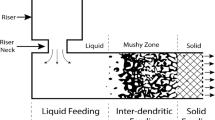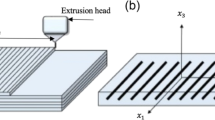Abstract
Flexible rolling is a novel forming process for three-dimensional surface parts using a pair of bendable rolls. By controlling the distribution of the gap between the upper and lower forming rolls in the rolling process, the sheet metal is nonuniformly thinned in the thickness direction and the longitudinal elongation is different in the width direction of the sheet metal, which makes the sheet metal deform in rolling direction. With the rotation of the bendable rolls, the sheet metal is deformed consecutively and a three-dimensional surface part could be obtained. A small experimental device has been designed. Finite element analysis (FEA) model is established. Spherical surface and saddle surface are simulated, and their experimental results are presented. The major purpose of the present work is to analyze the forming precision of flexible rolling and the reasons for the shape errors through simulated and experimental results. The results demonstrate that the proposed process is a feasible and effective way of forming three-dimensional surface parts.
Similar content being viewed by others
References
Mori K, Yamamoto M, Osakada K (1996) Determination of hammering sequence in incremental sheet metal forming using a genetic algorithm. J Mater Process Technol 60:463–468
Iseki H, Naganawa T (2002) Vertical wall surface forming of rectangular shell using multistage incremental forming with spherical and cylindrical rollers. J Mater Process Technol 130-131:675–679
Aerens R, Eyckens P, Van Bael A, Duflou JA (2010) Force prediction for single point incremental forming deduced from experimental and FEM observations. Int J Adv Manuf Technol 46:969–982
Ambrogio G, Filice L, Guerriero F, Guido R, Umbrello D (2011) Prediction of incremental sheet forming process performance by using a neural network approach. Int J Adv Manuf Technol 54:921–930
Li Q, Lovell M (2008) Cross wedge rolling failure mechanisms and industrial application. Int J Adv Manuf Technol 37:265–278
Wang MH, Xiang D, Xiao C, Zhou J, Jia Z (2012) Influence of cooling condition of tools on central deformation of workpiece and tool wear in cross wedge rolling. Int J Adv Manuf Technol 59:473–482
Richter-Trummer V, Koch D, Witte A, Dos Santos JF, De Castro PMST (2013) Methodology for prediction of distortion of workpieces manufactured by high speed machining based on an accurate through-the-thickness residual stress determination. Int J Adv Manuf Technol 68:2271–2281
Li QH, Wu LB, Li FG, Liu TY, Wang SG, Wei ZJ, Su CM (2013) Experiments study on the rolling process for heavy disk. Int J Adv Manuf Technol 65:1171–1175
Yamashita I, Yamakawa T (1988) Apparatus for forming plate with a double-curved surface. United States 4770017
Yoon SJ, Yang DY (2003) Development of a highly flexible incremental roll forming process for the manufacture of a doubly curved sheet metal. CIRP Ann Manuf Technol 52(1):201–204
Yoon SJ, Yang DY (2005) An incremental roll forming process for manufacturing doubly curved sheets from general quadrilateral sheet blanks with enhanced process features. CIRP Ann Manuf Technol 54(1):221–224
Shim DS, Yang DY, Han MS, Chung SW, Kim KH, Roh HJ (2008) Experimental study on manufacturing doubly curved plates using incremental rolling process. ICTP 2008 (The 9th International Conference on Technology of Plasticity) pp. 2378–2383
Shim DS, Yang DY, Kim KH, Han MS, Chung SW (2009) Numerical and experimental investigation into cold incremental rolling of doubly curved plates for process design of a new LARS (line array roll set) rolling process. CIRP Ann Manuf Technol 58(1):239–242
Shim DS, Yang DY, Kim KH, Chung SW, Han MS (2010) Investigation into forming sequences for the incremental forming of doubly curved plates using the line array roll set (LARS) process. Int J Mach Tools Manuf 50:214–218
Li MZ, Hu ZQ, Cai ZY, Gong XP (2007) Method of efficient continuous plastic forming for freeform surface part. J Jilin Univ (Eng Technol Ed) 37:489–494 (in Chinese)
Hu ZQ, Li MZ, Cai ZY, Gong XP (2009) Continuous flexible forming of three-dimensional surface parts using bendable rollers. Mat Sci Eng Struct 499:234–237
Gong XP, Li MZ, Hu ZQ, Cai ZY (2010) Research on continuous multi-point forming technology for three-dimensional sheet metal. Int J Mater Prod Technol 38:210–222
Cai ZY, Li MZ, Lan YW (2012) Three-dimensional sheet metal continuous forming process based on flexible roll bending: principle and experiments. J Mater Process Technol 212:120–127
Cai ZY, Sui Z, Cai FX, Liu L (2013) Continuous flexible roll forming for three-dimensional surface part and the forming process control. Int J Adv Manuf Technol 66:393–400
Li MZ, Cai ZY, Li RZ, Lan YW, Qiu NJ (2012) Continuous forming method for three-dimensional surface parts based on the rolling process using bended roll. Chin J Mech Eng 48:44–49 (in Chinese)
Cai ZY, Li MZ (2013) Principle and theoretical analysis of continuous roll forming for three-dimensional surface parts. Sci China Technol Sci 2:351–358
Author information
Authors and Affiliations
Corresponding author
Rights and permissions
About this article
Cite this article
Wang, D., Li, M. & Cai, Z. Research on forming precision of flexible rolling method for three-dimensional surface parts through simulation. Int J Adv Manuf Technol 71, 1717–1727 (2014). https://doi.org/10.1007/s00170-013-5581-x
Received:
Accepted:
Published:
Issue Date:
DOI: https://doi.org/10.1007/s00170-013-5581-x




